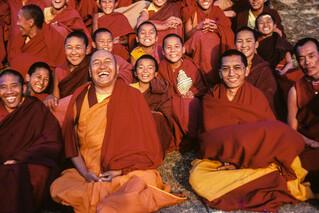Dear Friends,
Happy Chotrul Duchen, the Day of Miracles! Today, February 24, we celebrate the completion of the Great Prayer Festival, Monlam Chenmo, the festival of practice and meritorious activities that follows Losar, the Tibetan New Year. Lama Tsongkhapa chose the Monlam Chenmo to coincide with the anniversary of incredible events in Shakyamuni Buddha's life traditionally celebrated during the first two weeks of the lunar new year. Please see Lama Zopa Rinpoche's advice on how to make the Fifteen Days of Miracles most beneficial.
Don't forget to take advantage of the special discount on Big Love: The Life and Teachings of Lama Yeshe before the offer ends on February 25! Use this coupon code "BigLove15Days" to receive 50% off the original price, plus shipping, when you check out on our website. Don't miss out on ordering your copy today!
FROM THE VIDEO ARCHIVE: The Suffering of Pleasure
This month from the video archive we bring you another excerpt from a Dharma discourse given by Lama Zopa Rinpoche at Maitreya Instituut, Amsterdam, in November 1998. In this third excerpt, Rinpoche discusses how we need to use our wisdom to examine our yearning for feelings of pleasure so we can realize how chasing after samsaric pleasures always leads to a dead-end road full of suffering.
Visit and subscribe to the LYWA YouTube channel to view more videos freely available from our archive. See the FPMT YouTube channel for many more videos of Lama Zopa Rinpoche’s teachings.
ON THE LYWA PODCAST: The living heart of compassion
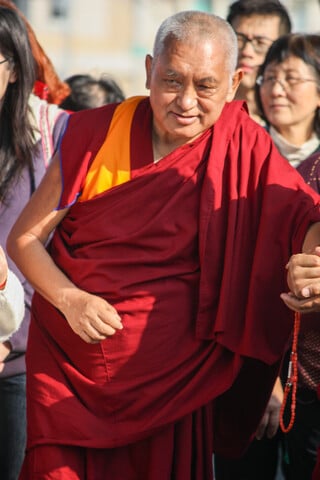 Compassion should be at the heart of our lives, at the center of all our relationships, and in all our practices.
Compassion should be at the heart of our lives, at the center of all our relationships, and in all our practices.
—Lama Zopa Rinpoche
This month on the LYWA podcast, Lama Zopa Rinpoche gives the transmission of the mantra and dharani of Chenrezig, the Buddha of Compassion, and explains why reciting these mantras helps us to develop compassion from the center of our heart for all beings and especially for those we see as the enemy. These teachings were given by Rinpoche during a Maitreya puja at Shakyamuni Center in Taichung, Taiwan, in March 2007. You can follow along with the transcript on our website.
The LYWA podcast contains hundreds of hours of audio, each with links to the accompanying lightly edited transcripts. See the LYWA podcast page to search or browse the entire collection by topic or date, and for easy instructions on how to subscribe.
BIG LOVE AUDIOBOOK HEART PROJECT
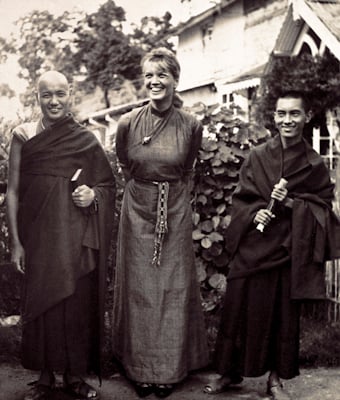 We’re happy to share with you another audiobook installment of Big Love: The Life and Teachings of Lama Yeshe, written by Adele Hulse. Organized by Janet Brooke, this heart project is comprised of narrations recorded by personal friends of the late Åge Delbanco (Babaji), one of Lama Yeshe's earliest students.
We’re happy to share with you another audiobook installment of Big Love: The Life and Teachings of Lama Yeshe, written by Adele Hulse. Organized by Janet Brooke, this heart project is comprised of narrations recorded by personal friends of the late Åge Delbanco (Babaji), one of Lama Yeshe's earliest students.
This month we bring you Chapter 5. 1967: Thubten Yeshe Meets a Russian Princess, narrated by Shasta Wallace. Chapter 5 describes the life of Zina Rachevsky, the story of how she first met Lama Yeshe and Lama Zopa Rinpoche, and what happened after she became the Lamas' first Western student.
WHAT'S NEW ON OUR WEBSITE
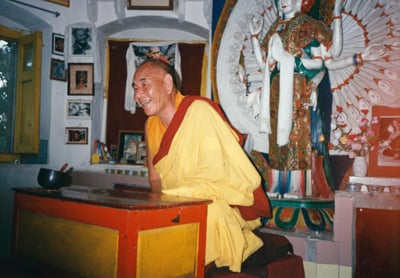 This month we have selected several short excerpts from Kopan Course No. 40 for you to enjoy. Read Rinpoche’s tribute to Geshe Lama Konchog and his advice on how to integrate Dharma into daily life. Rinpoche also teaches on the clear light nature of mind and reminds us of the shortcomings of samsara.
This month we have selected several short excerpts from Kopan Course No. 40 for you to enjoy. Read Rinpoche’s tribute to Geshe Lama Konchog and his advice on how to integrate Dharma into daily life. Rinpoche also teaches on the clear light nature of mind and reminds us of the shortcomings of samsara.
We have a new French translation to share with you. Excerpts from Big Love, Volume 1, have been translated into French by Michelle le Dimna. First published in Kalachakra Centre’s newsletter, the extracts have been collated and are now available for free download as a PDF. We also have a new Vietnamese translation, Chapter 4: A Brief History of Maitreya Buddha. This teaching is excerpted from the book Universal Love by Lama Yeshe.
Every month we share new advices for Lama Zopa Rinpoche’s Online Advice Book, adding more than 100 new entries every year on a variety of topics. More precious than ever, there are now more than 2,200 of Rinpoche’s advices online. Here are a few more:
- Practices for the Four Special Days: Rinpoche advised these practices for students on the four holy days of the Tibetan Buddhist calendar, and on solar and lunar eclipse days.
- Rejoice in a Worthwhile Life: Rinpoche sent this message to a nun who was close to death and had written to confess before passing away.
- Food and Water Charity for the Pretas: A student wanted to offer food and blessed water to the hungry ghosts, but their apartment did not have a balcony so they had to do it inside. The student asked Rinpoche if that was OK.
You can always find a list of all the newly posted advices from Lama Zopa Rinpoche on our website.
Shipping updates on LYWA Books
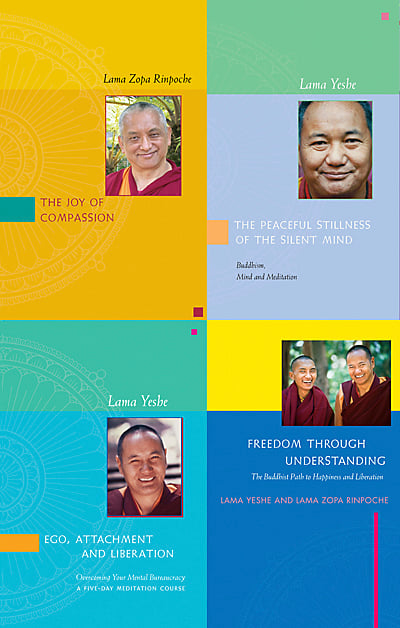 We have some important shipping rate updates to share with you. If your delivery address is in Australia, please note that FedEx has recently added surcharges for deliveries to some regional areas. As a result, we may not be able to send your order for the rate offered on our website. If we are unable to send your order for the amount collected, we will contact you to discuss your options. If you decide to cancel your order in these circumstances, we will issue a full refund to you. If you would like to receive a shipping estimate before placing your order, please feel free to contact us.
We have some important shipping rate updates to share with you. If your delivery address is in Australia, please note that FedEx has recently added surcharges for deliveries to some regional areas. As a result, we may not be able to send your order for the rate offered on our website. If we are unable to send your order for the amount collected, we will contact you to discuss your options. If you decide to cancel your order in these circumstances, we will issue a full refund to you. If you would like to receive a shipping estimate before placing your order, please feel free to contact us.
No matter where you are, if the shipping costs are prohibitive for you, please remember:
- Electronic versions of almost all of our titles are available in a variety of ways: to read online on our website; as a free PDF download; as an ebook through various ebook vendors; and as audiobooks. Please visit the book's page in our online store to see all the available options.
- You can purchase a print copy of some of our titles through Amazon's Print-on-Demand service. Depending on your location, the shipping may be more affordable. Note: if you are in Australia, Amazon prints locally and can mail to you for a domestic shipping rate.
- You may be able to pick up a copy of our books at your local FPMT center. Visit the FPMT website to locate your nearest center.
NEW LAMRIM YEAR PROGRAMS
 We are happy to share that two more FPMT centers have started programs based on the LYWA publication Lamrim Year. Every week Shiwa Lha Center in Brazil releases a new downloadable PDF of the meditations from Lamrim Year. Once the program concludes, the center plans to release the Portuguese translation of the book. Choe Khor Sum Ling in Bangalore, India, is sharing an audio recording of a page a day from Lamrim Year on their YouTube podcast.
We are happy to share that two more FPMT centers have started programs based on the LYWA publication Lamrim Year. Every week Shiwa Lha Center in Brazil releases a new downloadable PDF of the meditations from Lamrim Year. Once the program concludes, the center plans to release the Portuguese translation of the book. Choe Khor Sum Ling in Bangalore, India, is sharing an audio recording of a page a day from Lamrim Year on their YouTube podcast.
Here’s some of the feedback they shared with us:
Thank you for the incredible effort of putting this book together. I've been doing the meditations myself in my morning practice and you just can't imagine how incredibly helpful it has been. Hope it can help many others! Can't express my gratitude enough.
—Paula, Shiwa Lha CenterI just wanted to say thank you to Lama Yeshe Wisdom Archive for bringing out such a wonderful tribute and book to the teachings on lamrim by Kyabje Lama Yeshe and Kyabje Lama Zopa Rinpoche.
—Dee, Choe Khor Sum Ling Center
You'll also want to stay tuned for the forthcoming Spanish translation of Lamrim Year by Ediciones Dharma! Don't forget to check out the free Lamrim Year Companion website and download the free Lamrim Year Crosswalk PDF, a tool to support students studying the lamrim.
Remembering Sister Max
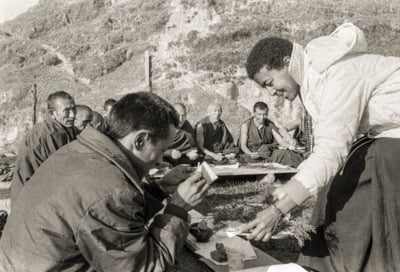 Our beloved friend, sister, and Mother of Kopan, Max Mathews, known to many as “Mummy” or “Sister” Max, passed away on February 16, 2024. We celebrate her long life and her incomparable dedication to Lama Yeshe and Lama Zopa Rinpoche, which enabled Kopan Monastery to become what it is today.
Our beloved friend, sister, and Mother of Kopan, Max Mathews, known to many as “Mummy” or “Sister” Max, passed away on February 16, 2024. We celebrate her long life and her incomparable dedication to Lama Yeshe and Lama Zopa Rinpoche, which enabled Kopan Monastery to become what it is today.
It is impossible to imagine what Kopan (and the FPMT) might have been without her. When I first arrived at Kopan in the fall of 1972, Sister Max was single-handedly supporting the Lamas, thirty or so young Sherpa monks there at the time and the entire monastery infrastructure. She was a teacher at the American Lincoln School in Kathmandu and donated her entire salary to Kopan. Her generosity and devotion to Lama and Rinpoche were exemplary and inspiring and motivated many of us to devote ourselves to trying to emulate her in helping the Lamas in their mission to preserve and spread the Dharma for the enlightenment of all sentient beings. Today we see the incredible results. It would not have happened without her.
I’m so grateful. I owe everything to the Tibetans. And anyone who gets the chance, if you pass it up you’ve missed the greatest opportunity you’ll ever have.
—Maryjane “Max” Mathews, 2023
You can learn more about Sister Max's life in this 2020 interview where she tells her own story about her relationships with the Lamas. You can also read about Mummy Max’s first trip to Lawudo, as told by her old friend Judy Weitzner, and find an excerpt about her in Big Love here.
Thanks so much for all your interest and support. Please read on for this month's teaching by Rinpoche on the importance of contemplating our death from the bottom of our hearts.
Big love,

Nick Ribush
Director
THIS MONTH'S TEACHING: DEATH MIGHT COME FIRST
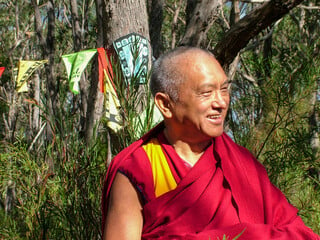 [The Heart’s Utmost Need by Pabongka Rinpoche] is the very heart advice, or practice from deep inside the heart. This advice about death is something to think about seriously from the bottom of our heart. We are not just doing research on death, like for a university thesis. Here we are seriously thinking about our own death from the bottom of our heart.
[The Heart’s Utmost Need by Pabongka Rinpoche] is the very heart advice, or practice from deep inside the heart. This advice about death is something to think about seriously from the bottom of our heart. We are not just doing research on death, like for a university thesis. Here we are seriously thinking about our own death from the bottom of our heart.
We are looking at our own death, mainly to persuade us to practice Dharma; so that we don’t put off our practice for many months or many years or leave it for future lives. We think, “First I will do this (the works for this life), then I will do that later.” In this way we put off Dharma practice for many months or years.
It persuades us to practice immediately, so in that way, we do the practice and don’t waste our life. Otherwise, there’s the risk that not only will we waste our life, but death might come first, before the practice. There’s the danger that even though we’re wishing and planning to practice, death might come before the practice. If we don’t hurry up, death might come before the practice, and then we will miss out. I think that’s the main point.
Also, it is very useful to see other people dying, especially family members, friends or people that we know. It’s a great teaching, a great reminder to practice Dharma. Practicing Dharma is not so much chanting mantras or doing other external things. Here, seeing the death of people we know, of family members or even people we live with, really makes us look at our life seriously. Our entire life up until now has passed in distraction.
Of course, we recited prayers, chanted mantras and this and that; but the real practice of renunciation didn’t happen. The cutting of desire, of clinging to this life, didn’t happen. The actual practice of Dharma didn’t happen. Here it reminds us to look at our own life up to now, at how we spent it. We have done many activities, but we haven’t really given up the desire clinging to this life. Here it reminds us of that.
When we see even the deaths of others, of family members or people that we know, it brings our attention to the fact that in the past we haven’t seriously practiced. It reminds us that now we have to give up all that distraction or desire, which has no meaning at all. Now we really have to dedicate our life to serious practice, freeing ourselves from desire.
We should practice this continuously, day and night. Other than this, nothing else in life is meaningful. There’s nothing there that will be useful at the time of death. So, it reminds us to really pay attention to our life and to practice seriously. Here seriously has mainly to do with our mind, with the purity of our mind, with its being free from the desire clinging to this life.
So, it’s very useful to see others’ deaths, and, of course, to visualize our own death. Pabongka says that the most effective one is to visualize ourselves as dead, on the bed, then visualize all the things that usually happen when someone dies. The members of our family will come and cry. Our body will then be put in a coffin and taken to the cemetery. Before that, our breathing will change, and we will know that we’re dying and that everything will have to be left: our family, all our possessions and even our body. Everything will have to be left, and our consciousness alone will go to the next life.
This is like the tantric practice of meditating on the three kayas, in which we meditate on the dharmakaya, sambhogakaya and nirmanakaya that we’re going to achieve in the future as having happened now. In that way, we purify ordinary death, intermediate state and rebirth, and then use them to achieve enlightenment, the result-time three kayas. So, this effective meditation on impermanence and death is a little like that. We visualize that the whole process that is going to happen later is happening now, and then see what happens to our mind.
However, the main point is to persuade us to practice Dharma.
Lama Zopa Rinpoche gave this teaching on April 22, 2004 at the Mahamudra Retreat held in Mylor, South Australia. Edited by Ven. Ailsa Cameron; second light edit by Sandra Smith. You can listen to teachings from this retreat and read along with the unedited transcripts on our website. The Heart’s Utmost Need (formerly Heart-Spoon) by Pabongkha Rinpoche is freely available as a PDF produced by Piero Sirianni. You can also find this text in the FPMT Catalogue























